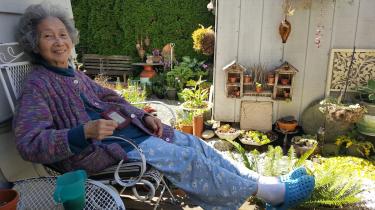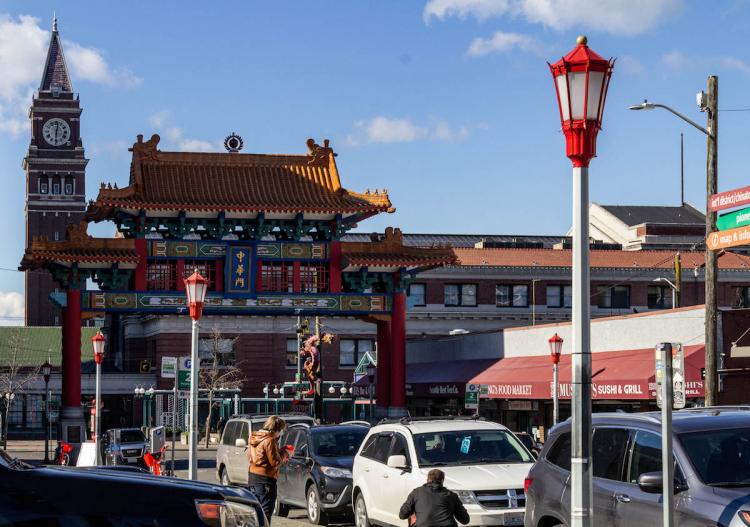Researchers explore the complex challenges facing Asian Americans and Pacific Islanders in accessing and using dementia healthcare services.
By Franklin X. Faust
As published in Dimensions Magazine - Spring 2019
A set of photographs depict the cherished memories of Anna Dang, an elderly woman of Asian American heritage. One by one, the photographic memories start to fade to black, and Trang Tu, the woman’s daughter and full-time caregiver, opens up about her mother’s dementia. This is a scene from GAPS, a documentary by Seattle filmmaker Peter Trinh. GAPS tells the story of one family’s experience with Alzheimer’s disease and sheds light on the unique challenges facing Asian American communities in accessing dementia care.
“My goal was to create a documentary that highlights the stigmas, lack of awareness, imbalance of the medical system, and the heavy burden that comes with medical issues that are seen with Asians that are not as apparent in other ethnicities,” says Trinh. “Ultimately, this film aims to raise awareness on these cultural issues.”

Anna Dang, courtesy Trang Tru
Trinh’s goals are in line with those of the Healthy Brain Research Network’s Coordinating Center (UW HBRN) at the University of Washington. Under the leadership of Dr. Basia Belza, PhD, UW Professor of Nursing at the de Tornyay Center for Healthy Aging, the center recently produced the Asian American and Pacific Islander Dementia Action Guide for Service Providers. The action guide explains how cultural factors pose unique problems that influence dementia outcomes in Asian American communities, presents research findings on effective, culturally appropriate messaging, and offers outreach recommendations and resources to help achieve inclusion of Asian Americans in dementia care services. By reaching out with their new guide and working with both international and mainstream clinics, they aim to be a force for change and address the barriers to care affecting Seattle’s vibrant Asian American communities.
One of the cultural barriers highlighted both in GAPS and UW HBRN’s action guide is the stigma surrounding dementia. Nikki Eller, MPH, Research Investigator at the Washington State Department of Health, worked on the action guide and has researched the implications of this stigma. Most cultures have some level of stigma associated with dementia, but Eller has found that it is particularly pronounced in Asian American communities. According to her, this stigma can play a large role in discouraging families from seeking care. “Bringing concerns of an older family member’s memory to their attention and asking them to see a specialist is a very delicate conversation for anybody,” Eller says, “But the more definite stigma surrounding dementia seen in many Asian cultures can make these sorts of conversations particularly difficult and even less likely to take place.”
The way people talk about dementia can frame people’s perceptions of it, and the words used within a culture influence both awareness of the disorder and response to a diagnosis. “Alzheimer’s is a disease which affects millions of Asians,” says Trinh. “Yet in most Asian countries and cultures, a word does not exist to describe it.” A lack of words for dementia can make dialogue with a family member and screening by a healthcare provider less likely to occur. According to Edie Yau, the director of Diversity & Inclusion at the Alzheimer’s Association, ‘Alzheimer’s disease’ translates into colloquial Chinese as ‘crazy-catatonic disease’. While each individual’s personal experiences factor into how they react and respond to a diagnosis, the translation’s association with mental illness can make someone less likely to seek out care later. “When your mother’s given a diagnosis of ‘crazy’ or ‘catatonic’, it doesn’t really encourage you to reach out for help,” says Eller. “Many people don’t want to admit that to their communities.”
From a structural perspective, many healthcare offices don’t have the tools to effectively translate a diagnosis and help non-English speakers, such as first-generation immigrants. Because of this lack of resources, mainstream clinics often refer these people to international clinics. However, mainstream and international clinics don’t always coordinate. “Many healthcare providers refer first generation immigrants to international clinics for follow up care,” says Eller. “But those clinics end up being a sort of black box – they don’t know what happens to those patients afterwards.” Without strong communication and referral networks between clinics, it can be more difficult to ensure that patients receive ongoing care and resources.
Cultural tradition also plays a factor. Eller has found in her research that filial piety, a sense of duty of the young to respect and take care of their elderly family members, is present in many Asian American communities. Asian Americans are much more likely to take on caregiving responsibilities for elderly relatives than any other ethnic group, and Trang Tu’s story in GAPS is representative of many cases today where a child acts as the sole caregiver of a parent with dementia. While a strong tradition of responsibility and duty for the young to take care of the old can be beneficial, dementia poses challenges beyond the scope of normal aging. According to Eller, when strong convictions of filial piety translate to a lower willingness to seek out or accept help from outside sources, it often amounts to worse results for both the patient and caregiver.
The combination of these cultural factors and the lack of resources specific to Asian American communities and languages adds up to many people not reaching out for help in the early stages. “A common trend is for people to try and do everything on their own to take care of their parents, until they burn out,” says Eller. “But if they could be encouraged to reach out earlier, it might not have to come to that.” Dr. Belza’s team identified that the best possible outcomes for people living with Alzheimer’s hinge on early detection, intervention, and management of the disease by a healthcare professional. Because the cultural and structural factors that Asian American communities experience lead to less help early on and worse outcomes, it is particularly important that these unique challenges are addressed.
The work to address these problems and create the action guide started with a project from the affiliate Healthy Brain Research Network member center at the University of Pennsylvania. In 2017, the Pennsylvania center developed messages to encourage African Americans to accompany an aging parent with cognitive changes to see a healthcare provider. Dr. Belza then launched an effort to repeat the study at member centers across the country. “We quickly came to realize that in order to make effective messages, we needed to tailor them to different communities,” says Dr. Belza. “At our center, we chose to focus on Asian American communities for our study because we have strong relationships with local Asian communities and passionate partners who share our goals.”
One of these partners was the National Asian Pacific Center on Aging, who helped the UW HBRN organize Chinese and Japanese focus groups to assess the acceptability of their messaging. Analysis of the focus group data reinforced the evidence of mental health stigma and dementia care barriers such as lack of awareness in Asian American communities. Once the guide was complete, the team was awarded a Seattle Innovation Fund grant which allowed the center to effectively distribute the guide and make a real world impact. The center reached out to clinics in Seattle, such as the UW Memory and Brain Wellness Center, the International Community Health Services clinic, and Asian American-focused health care settings, such as the Asian Counseling and Referral Service and Keiro Northwest.
Since the UW Coordinating Center’s outreach to our clinic last year, our team has taken actions to make our care more accessible to the Asian American community. So far, our clinic translated the Living with Memory Loss handbook into Chinese and Vietnamese. Making educational materials and resources more culturally appropriate is a good step along the path towards reaching inclusion and access for Asian communities. The Memory and Brain Wellness Center aims to help model our efforts for other clinics.
Raising awareness of the challenges that Asian American communities face in accessing dementia care is a necessary step towards adapting our systems and reaching better public health outcomes. To help fulfill this need, Dr. Belza’s team not only aims to use their guide to raise awareness among practicing service providers, but they also hope to reach the next generation of service providers. In one example of success, Dr. Tamara Cunitz, MN, RN, of the UW School of Nursing, used the guide as a case example for her students. “It was great to see these students take our work and learn how to implement it into practice before they even start providing services,” says Dr. Belza, “That’s exactly what you want to happen.” To her, this story is an exemplary example of how the goals of the guide were able to come to fruition.
The next challenge to tackle may be in the way ethnic data is recorded. When filling out paperwork at the doctor’s office and checking the boxes for race and ethnicity, individuals might find that the options fall short of reflecting their actual identity. The term “Asian American” encompasses over fifty subpopulations and over one hundred languages, so these generalized options mask a myriad of differences between cultures. “Lumping all these different countries, and peoples, and cultures and languages all together – it’s convenient. Culture does matter,” says Dr. Alan J. Chun, M.D. of the International Community Health Services, in his interview in GAPS.
This nonspecific way that clinics tend to collect ethnic information also means less information for researchers to work with. “Not just checking the Asian American box, but getting down to the specific culture people are coming from can make a big impact,” says Eller. “It can help us fill in the gaps in the data in terms of the different rates of risk for dementia between subpopulations, and also give us insight into cultural trends we might be seeing.” Valuing the differences between cultures can give researchers the resources to tease apart the risk factors for cognitive decline, and ultimately reach a more complete understanding of Alzheimer’s disease and dementia in underserved communities.
The action guide is a strong step towards educating people about the challenges Asian American communities face in accessing dementia care, but there is much work to be done in order to bridge the gaps themselves. “We believe these kinds of efforts to promote culturally relevant dementia care are vitally important,” says Marigrace Becker, MSW, Program Manager of Community Education and Impact at the UW Memory and Brain Wellness Center. “As health care and service providers become more aware of the varied cultural experiences of dementia, more people will receive the kind of dementia care they desire and deserve. We’re excited to help expand this conversation by helping to share the GAPS documentary with the wider community.” •
Franklin X. Faust is a research scientist who works with the UW Integrated Brain Imaging Center to interpret neuroimaging data, in coordination with ADRC researchers. He is a member of the ADRC communications team and helps with outreach.






